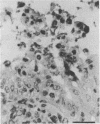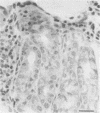Abstract
A modified removable intestinal tie adult rabbit diarrhea (RITARD) model was used to investigate the intestinal pathology, intestinal bacterial colonization, intestinal fluid volume, and onset of diarrhea caused by non-O1 Vibrio cholerae. Three strains of non-O1 V. cholerae were studied. RITARD rabbits challenged with 10(3) CFU of strain NRT36S (a strain previously shown to cause diarrhea in volunteers) developed grade 3 diarrhea at 48 to 72 h. The mean counts of non-O1 V. cholerae isolated were 9.3 +/- 0.07 and 8.7 +/- 0.7 CFU/g from the small and large intestines, respectively. Histologic examination showed necrosis of the luminal epithelium in the colon and mild inflammatory cell infiltration in the adjacent lamina propria. The severity and extent of intestinal damage by strain NRT36S was dose dependent. Higher doses of strain NRT36S caused severe necrotizing colitis and enteritis, with bacteremia and mortality at less than 24 h in RITARD rabbits challenged with 10(9) CFU and at less than 48 h in RITARD rabbits challenged with 10(4) CFU. Electron and light microscopy demonstrated invasion of NRT36S into the luminal epithelial cells of the intestine. Challenge of RITARD rabbits with non-O1 V. cholerae A-5 and 2076-79 (strains which did not cause diarrhea in volunteers) did not cause diarrhea or intestinal pathology. Intestinal colonization was transient: at 72 h postchallenge, animals inoculated with strain A-5 were culture negative, while only low numbers of strain 2076-79 were detectable (approximately 0.4 to 0.8 CFU/g). Our data highlight the utility of the RITARD model, when combined with appropriate pathologic and bacteriologic studies, for obtaining insights into pathophysiologic mechanisms of enteric disease by non-O1 V. cholerae. In agreement with volunteer studies, non-O1 V. cholerae NRT36S is clearly pathogenic in this model; direct cell invasion may play a role in its ability to cause illness.
Full text
PDF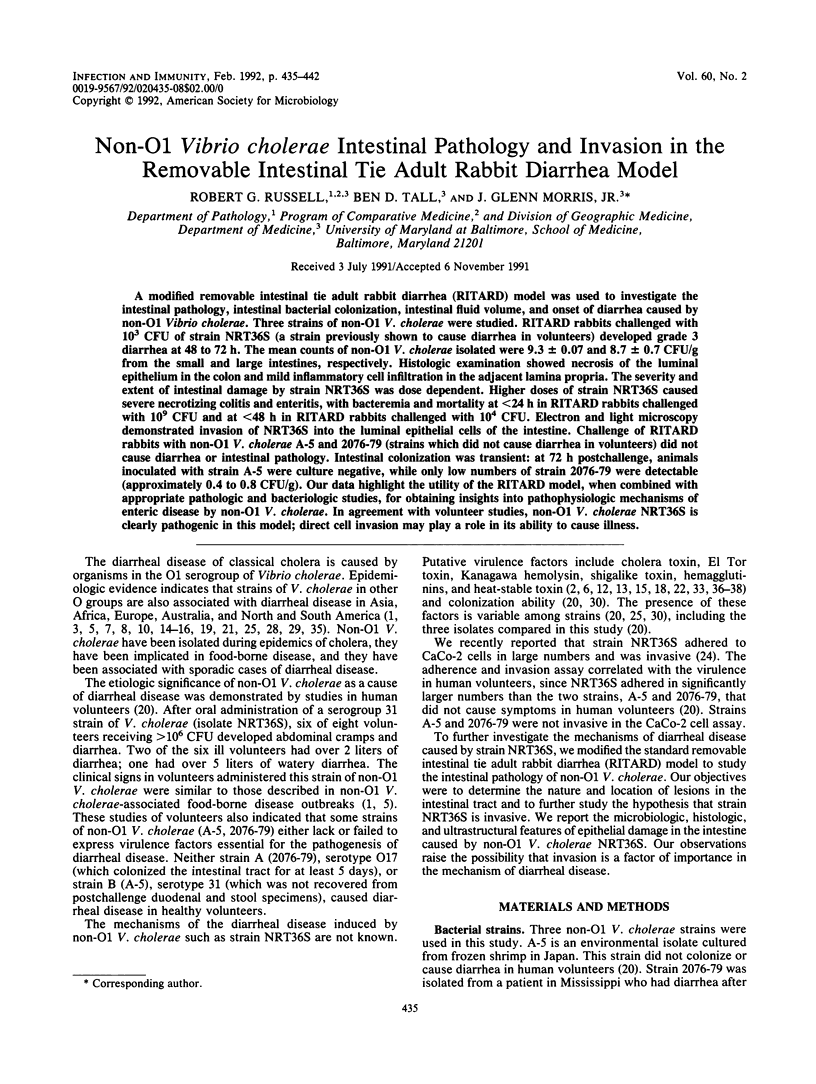
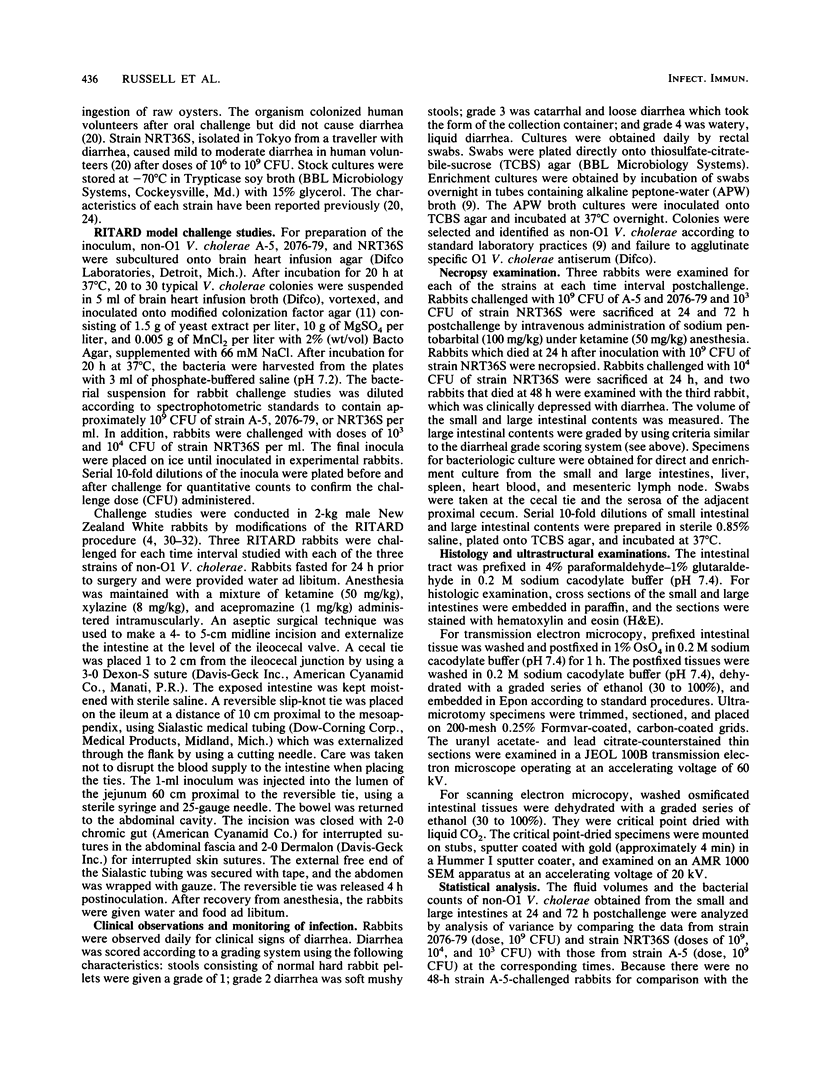




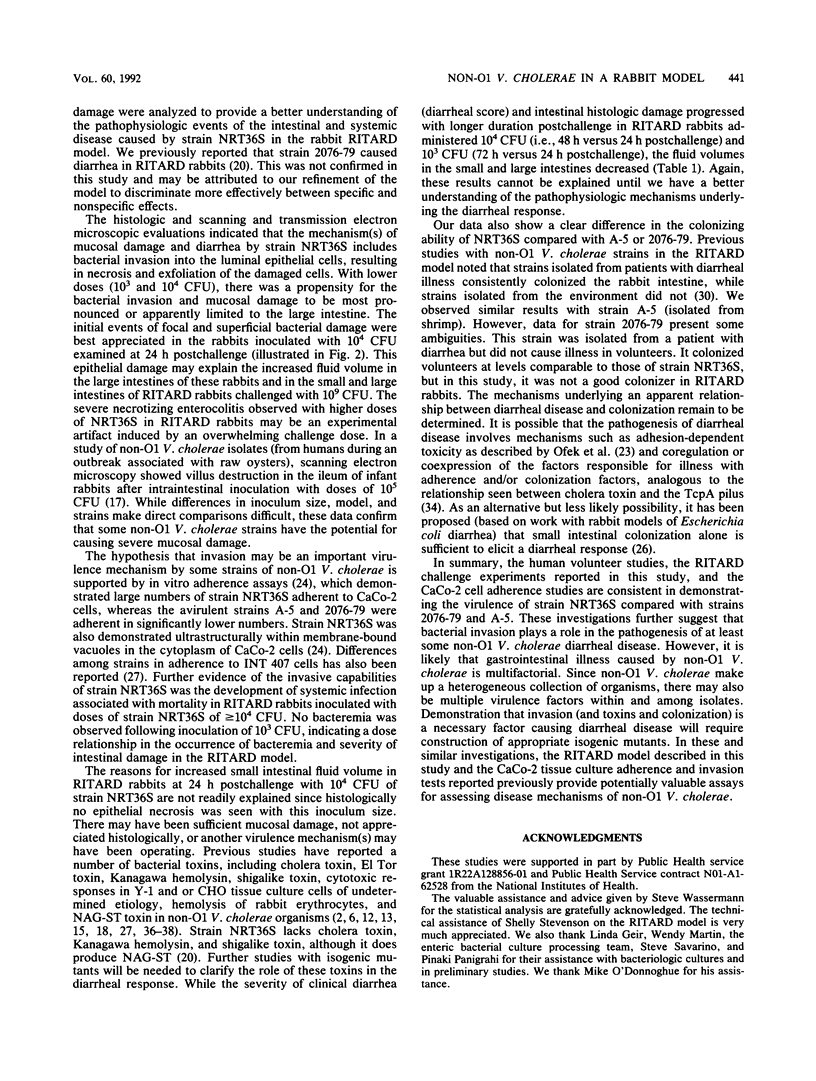
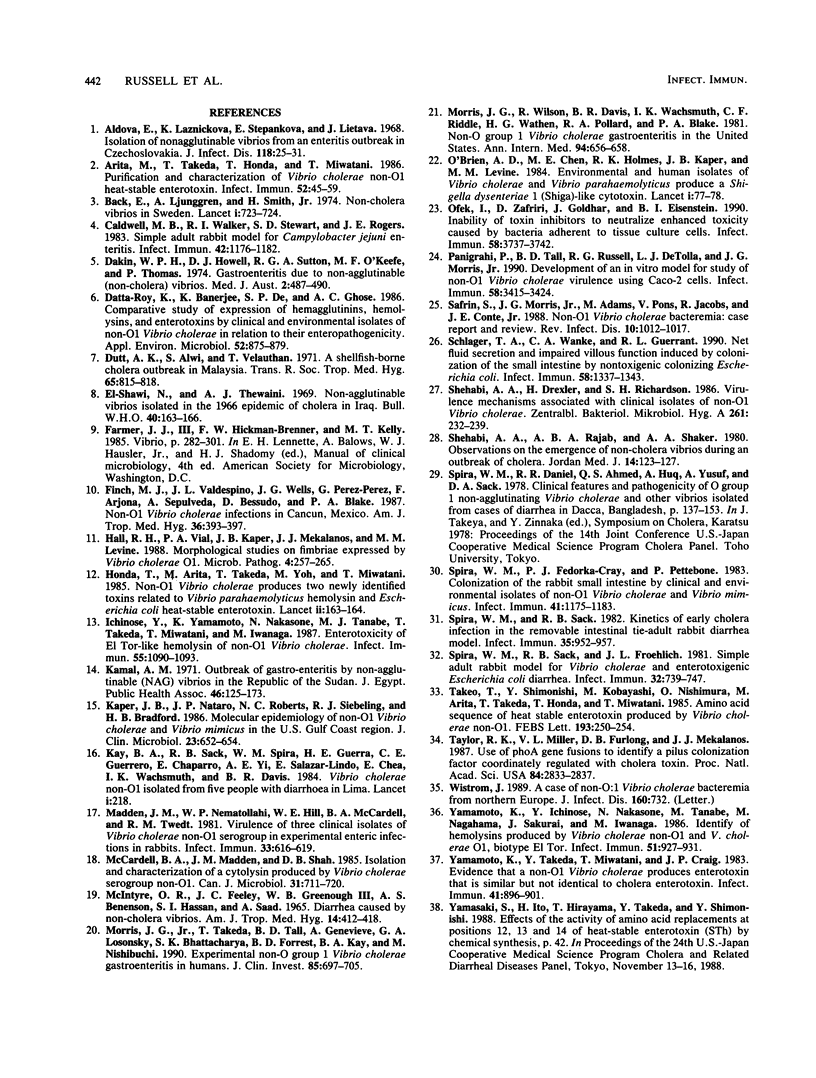
Images in this article
Selected References
These references are in PubMed. This may not be the complete list of references from this article.
- Aldová E., Láznicková K., Stepánková E., Lietava J. Isolation of nonagglutinable vibrios from an enteritis outbreak in Czechoslovakia. J Infect Dis. 1968 Feb;118(1):25–31. doi: 10.1093/infdis/118.1.25. [DOI] [PubMed] [Google Scholar]
- Arita M., Takeda T., Honda T., Miwatani T. Purification and characterization of Vibrio cholerae non-O1 heat-stable enterotoxin. Infect Immun. 1986 Apr;52(1):45–49. doi: 10.1128/iai.52.1.45-49.1986. [DOI] [PMC free article] [PubMed] [Google Scholar]
- Bäck E., Ljunggren A., Smith H., Jr Non-cholera Vibrios in Sweden. Lancet. 1974 Apr 20;1(7860):723–724. doi: 10.1016/s0140-6736(74)92921-3. [DOI] [PubMed] [Google Scholar]
- Caldwell M. B., Walker R. I., Stewart S. D., Rogers J. E. Simple adult rabbit model for Campylobacter jejuni enteritis. Infect Immun. 1983 Dec;42(3):1176–1182. doi: 10.1128/iai.42.3.1176-1182.1983. [DOI] [PMC free article] [PubMed] [Google Scholar]
- Dakin W. P., Howell D. J., Sutton R. G., O'Keefe M. F., Thomas P. Gastroenteritis due to non-agglutinable (non-cholera) vibrios. Med J Aust. 1974 Sep 28;2(13):487–490. doi: 10.5694/j.1326-5377.1974.tb70935.x. [DOI] [PubMed] [Google Scholar]
- Datta-Roy K., Banerjee K., De S. P., Ghose A. C. Comparative study of expression of hemagglutinins, hemolysins, and enterotoxins by clinical and environmental isolates of non-O1 Vibrio cholerae in relation to their enteropathogenicity. Appl Environ Microbiol. 1986 Oct;52(4):875–879. doi: 10.1128/aem.52.4.875-879.1986. [DOI] [PMC free article] [PubMed] [Google Scholar]
- Dutt A. K., Alwi S., Velauthan T. A shellfish-borne cholera outbreak in Malaysia. Trans R Soc Trop Med Hyg. 1971;65(6):815–818. doi: 10.1016/0035-9203(71)90097-6. [DOI] [PubMed] [Google Scholar]
- Finch M. J., Valdespino J. L., Wells J. G., Perez-Perez G., Arjona F., Sepulveda A., Bessudo D., Blake P. A. Non-01 Vibrio cholerae infections in Cancun, Mexico. Am J Trop Med Hyg. 1987 Mar;36(2):393–397. doi: 10.4269/ajtmh.1987.36.393. [DOI] [PubMed] [Google Scholar]
- Hall R. H., Vial P. A., Kaper J. B., Mekalanos J. J., Levine M. M. Morphological studies on fimbriae expressed by Vibrio cholerae 01. Microb Pathog. 1988 Apr;4(4):257–265. doi: 10.1016/0882-4010(88)90086-1. [DOI] [PubMed] [Google Scholar]
- Honda T., Arita M., Takeda T., Yoh M., Miwatani T. Non-O1 Vibrio cholerae produces two newly identified toxins related to Vibrio parahaemolyticus haemolysin and Escherichia coli heat-stable enterotoxin. Lancet. 1985 Jul 20;2(8447):163–164. doi: 10.1016/s0140-6736(85)90277-6. [DOI] [PubMed] [Google Scholar]
- Ichinose Y., Yamamoto K., Nakasone N., Tanabe M. J., Takeda T., Miwatani T., Iwanaga M. Enterotoxicity of El Tor-like hemolysin of non-O1 Vibrio cholerae. Infect Immun. 1987 May;55(5):1090–1093. doi: 10.1128/iai.55.5.1090-1093.1987. [DOI] [PMC free article] [PubMed] [Google Scholar]
- Kaper J. B., Nataro J. P., Roberts N. C., Siebeling R. J., Bradford H. B. Molecular epidemiology of non-O1 Vibrio cholerae and Vibrio mimicus in the U.S. Gulf Coast region. J Clin Microbiol. 1986 Mar;23(3):652–654. doi: 10.1128/jcm.23.3.652-654.1986. [DOI] [PMC free article] [PubMed] [Google Scholar]
- Kay B. A., Sack R. B., Spira W. M., Guerra H. E., Guerrero C. E., Chaparro E., Yi A. E., Salazar-Lindo E., Chea E., Wachsmuth I. K. Vibrio cholerae non-O1 isolated from five people with diarrhoea in Lima. Lancet. 1984 Jan 28;1(8370):218–218. doi: 10.1016/s0140-6736(84)92133-0. [DOI] [PubMed] [Google Scholar]
- MCINTYRE O. R., FEELEY J. C., GREENOUGH W. B., 3rd, BENENSON A. S., HASSAN S. I., SAAD A. DIARRHEA CAUSED BY NON-CHOLERA VIBRIOS. Am J Trop Med Hyg. 1965 May;14:412–418. doi: 10.4269/ajtmh.1965.14.412. [DOI] [PubMed] [Google Scholar]
- Madden J. M., Nematollahi W. P., Hill W. E., McCardell B. A., Twedt R. M. Virulence of three clinical isolates of Vibrio cholerae non-O-1 serogroup in experimental enteric infections in rabbits. Infect Immun. 1981 Aug;33(2):616–619. doi: 10.1128/iai.33.2.616-619.1981. [DOI] [PMC free article] [PubMed] [Google Scholar]
- McCardell B. A., Madden J. M., Shah D. B. Isolation and characterization of a cytolysin produced by Vibrio cholerae serogroup non-O1. Can J Microbiol. 1985 Aug;31(8):711–720. doi: 10.1139/m85-135. [DOI] [PubMed] [Google Scholar]
- Morris J. G., Jr, Takeda T., Tall B. D., Losonsky G. A., Bhattacharya S. K., Forrest B. D., Kay B. A., Nishibuchi M. Experimental non-O group 1 Vibrio cholerae gastroenteritis in humans. J Clin Invest. 1990 Mar;85(3):697–705. doi: 10.1172/JCI114494. [DOI] [PMC free article] [PubMed] [Google Scholar]
- Morris J. G., Jr, Wilson R., Davis B. R., Wachsmuth I. K., Riddle C. F., Wathen H. G., Pollard R. A., Blake P. A. Non-O group 1 Vibrio cholerae gastroenteritis in the United States: clinical, epidemiologic, and laboratory characteristics of sporadic cases. Ann Intern Med. 1981 May;94(5):656–658. doi: 10.7326/0003-4819-94-5-656. [DOI] [PubMed] [Google Scholar]
- O'Brien A. D., Chen M. E., Holmes R. K., Kaper J., Levine M. M. Environmental and human isolates of Vibrio cholerae and Vibrio parahaemolyticus produce a Shigella dysenteriae 1 (Shiga)-like cytotoxin. Lancet. 1984 Jan 14;1(8368):77–78. doi: 10.1016/s0140-6736(84)90006-0. [DOI] [PubMed] [Google Scholar]
- Ofek I., Zafriri D., Goldhar J., Eisenstein B. I. Inability of toxin inhibitors to neutralize enhanced toxicity caused by bacteria adherent to tissue culture cells. Infect Immun. 1990 Nov;58(11):3737–3742. doi: 10.1128/iai.58.11.3737-3742.1990. [DOI] [PMC free article] [PubMed] [Google Scholar]
- Panigrahi P., Tall B. D., Russell R. G., Detolla L. J., Morris J. G., Jr Development of an in vitro model for study of non-O1 Vibrio cholerae virulence using Caco-2 cells. Infect Immun. 1990 Oct;58(10):3415–3424. doi: 10.1128/iai.58.10.3415-3424.1990. [DOI] [PMC free article] [PubMed] [Google Scholar]
- Safrin S., Morris J. G., Jr, Adams M., Pons V., Jacobs R., Conte J. E., Jr Non-O:1 Vibrio cholerae bacteremia: case report and review. Rev Infect Dis. 1988 Sep-Oct;10(5):1012–1017. doi: 10.1093/clinids/10.5.1012. [DOI] [PubMed] [Google Scholar]
- Schlager T. A., Wanke C. A., Guerrant R. L. Net fluid secretion and impaired villous function induced by colonization of the small intestine by nontoxigenic colonizing Escherichia coli. Infect Immun. 1990 May;58(5):1337–1343. doi: 10.1128/iai.58.5.1337-1343.1990. [DOI] [PMC free article] [PubMed] [Google Scholar]
- Shehabi A. A., Drexler H., Richardson S. H. Virulence mechanisms associated with clinical isolates of non-O1 Vibrio cholerae. Zentralbl Bakteriol Mikrobiol Hyg A. 1986 Apr;261(2):232–239. doi: 10.1016/s0176-6724(86)80040-2. [DOI] [PubMed] [Google Scholar]
- Spira W. M., Fedorka-Cray P. J., Pettebone P. Colonization of the rabbit small intestine by clinical and environmental isolates of non-O1 Vibrio cholerae and Vibrio mimicus. Infect Immun. 1983 Sep;41(3):1175–1183. doi: 10.1128/iai.41.3.1175-1183.1983. [DOI] [PMC free article] [PubMed] [Google Scholar]
- Spira W. M., Sack R. B., Froehlich J. L. Simple adult rabbit model for Vibrio cholerae and enterotoxigenic Escherichia coli diarrhea. Infect Immun. 1981 May;32(2):739–747. doi: 10.1128/iai.32.2.739-747.1981. [DOI] [PMC free article] [PubMed] [Google Scholar]
- Spira W. M., Sack R. B. Kinetics of early cholera infection in the removable intestinal tie-adult rabbit diarrhea model. Infect Immun. 1982 Mar;35(3):952–957. doi: 10.1128/iai.35.3.952-957.1982. [DOI] [PMC free article] [PubMed] [Google Scholar]
- Takao T., Shimonishi Y., Kobayashi M., Nishimura O., Arita M., Takeda T., Honda T., Miwatani T. Amino acid sequence of heat-stable enterotoxin produced by Vibrio cholerae non-01. FEBS Lett. 1985 Dec 2;193(2):250–254. doi: 10.1016/0014-5793(85)80163-0. [DOI] [PubMed] [Google Scholar]
- Taylor R. K., Miller V. L., Furlong D. B., Mekalanos J. J. Use of phoA gene fusions to identify a pilus colonization factor coordinately regulated with cholera toxin. Proc Natl Acad Sci U S A. 1987 May;84(9):2833–2837. doi: 10.1073/pnas.84.9.2833. [DOI] [PMC free article] [PubMed] [Google Scholar]
- Wiström J. A case of non-O:1 Vibrio cholerae bacteremia from northern Europe. J Infect Dis. 1989 Oct;160(4):732–732. doi: 10.1093/infdis/160.4.732. [DOI] [PubMed] [Google Scholar]
- Yamamoto K., Ichinose Y., Nakasone N., Tanabe M., Nagahama M., Sakurai J., Iwanaga M. Identity of hemolysins produced by Vibrio cholerae non-O1 and V. cholerae O1, biotype El Tor. Infect Immun. 1986 Mar;51(3):927–931. doi: 10.1128/iai.51.3.927-931.1986. [DOI] [PMC free article] [PubMed] [Google Scholar]
- Yamamoto K., Takeda Y., Miwatani T., Craig J. P. Evidence that a non-O1 Vibrio cholerae produces enterotoxin that is similar but not identical to cholera enterotoxin. Infect Immun. 1983 Sep;41(3):896–901. doi: 10.1128/iai.41.3.896-901.1983. [DOI] [PMC free article] [PubMed] [Google Scholar]
- el Shawi N., Thewaini A. J. Non-agglutinable vibrios isolated in the 1966 epidemic of cholera in Irag. Bull World Health Organ. 1969;40(1):163–166. [PMC free article] [PubMed] [Google Scholar]




